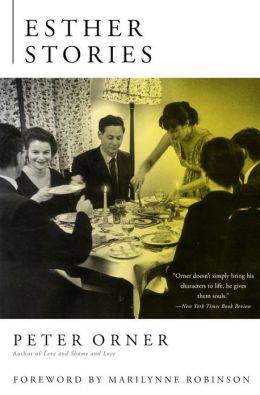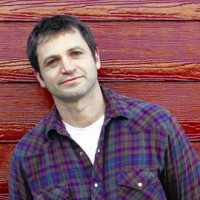A men’s prison organizes a cutthroat hockey game. A mass murderer writes a letter from his jail cell. A boy destroys the kite his failing father built, out of spite. Two boys play in the water under the bridge where Ted Kennedy careened off the road and killed Mary Jo Kopechne. An old couple lies their way through life, until their real stories become inseparable from the yarns they’ve spun around their duped friends and each other.
Stories—the way we tell them, the way we un-tell them, how they consume us and liberate us—once again find themselves at the obsessive focal point of Peter Orner’s most recent work of fiction. In Last Car Over the Sagamore Bridge, Orner delivers the compressed slice-of-life prose that has become the hallmark of his writing style. The several dozen pieces in this collection are all brief, yet contain universes, and each story is a keyhole that invites the reader to place her eye up close and see an entire landscape beyond.
Peter Orner is the acclaimed author of Love and Shame and Love, Esther Stories, and The Second Coming of Mavala Shikongo. His many accolades include a Guggenheim Fellowship, a Lannan Literary Fellowship, and two Pushcart Prizes. Known for his intimate, character-driven fiction, he often centers his narratives on the thorny terrains of adolescence and old age within the nuclear family. Chicago’s native son, his fiction frequently returns to the Midwest and its place in 20th century American history. His characters often seem stuck, as landlocked as Illinois, either negotiating their place in salt-of-the-earth communities or gunning for salvation through fantastical stories and lies. In Last Car Over the Sagamore Bridge, Orner revisits some characters where they left off in Love and Shame and Love, and creates others who are flawed, tangible, and scarily honest.
One of my favorite aspects of Last Car Over the Sagamore Bridge is the experiment in multiple types of framing. It’s all here—the epistolary, the story-within-a-story, the flashbacks and flash-forwards. There are few stories in this collection in which the characters are not telling their own stories. Orner knows that what makes us human: we make sense of the world through narrative.
***
The Rumpus: You are so great at compression. How do you decide when a story feels “done”? Do you ever feel the desire to cut it back even more, or go longer?
Peter Orner: I wish I had an answer. I revise and revise and revise. I’m not even sure “revise” is the right word. I work a story almost to death before it’s done. And maybe this is it: I beat a story to within an inch of its life—that’s when I know its done. Not before, not after.
Rumpus: I really enjoyed how these stories frequently occupied the world of convicts or prisoners. Where did some of those ideas come from? I’m thinking in particular of the Denny Coughlin story and the Nathan Leopold story.
 Orner: I’ve spent a lot of time in prisons, first doing legal work and later, teaching. I’ve been inside in a number of states—New York, Massachusetts, Montana, North Carolina. I got to say, Massachusetts had the worse conditions. Once you’re inside one of these places, you literally cross over into some other reality. It’s familiar in a lot of ways. I mean, you recognize the language, you can read the signs, and yet there’s something so bizarre about how deep you have to go, how many doors you literally have to pass through to get to the heart of these places. In my case, I’m only there a few hours at a time. But I’ve never been able to shake the trapped feeling. I’ve tried to imagine what it might feel like to endure this for years, which is why I write so often about prison.
Orner: I’ve spent a lot of time in prisons, first doing legal work and later, teaching. I’ve been inside in a number of states—New York, Massachusetts, Montana, North Carolina. I got to say, Massachusetts had the worse conditions. Once you’re inside one of these places, you literally cross over into some other reality. It’s familiar in a lot of ways. I mean, you recognize the language, you can read the signs, and yet there’s something so bizarre about how deep you have to go, how many doors you literally have to pass through to get to the heart of these places. In my case, I’m only there a few hours at a time. But I’ve never been able to shake the trapped feeling. I’ve tried to imagine what it might feel like to endure this for years, which is why I write so often about prison.
One story I’ve been trying to write for years, and haven’t been able to finish, is about a face I saw, just a glimpse of a face, in a max security prison in North Carolina. I’m still trying to understand what I saw in that guy’s face.
Rumpus: There’s something very dark and wintery about this book, and I can’t help but tie it to the frequent appearance of older characters. Like these stories are about the sunset years. Was that something you had in mind?
Orner: Dark and wintery is about right. Sometimes it’s a dark and wintery world, and I try and capture that. And true, my characters tend to be people who are looking back on a life lived, their joys, their regrets. A lot of people have said this is a dark book. And I agree, to a certain extent. And I got some wintery moods, for sure, and these went into the book. But it’s not darkness for darkness’s sake, you know what I mean? I think what I’m after, a lot of the time, is just honesty. What accounts for the fact that the stories we tell ourselves—the story we carry around and think of most often—are the dark ones? Maybe we have to wander around in the darkness to understand it?
Rumpus: How did the four sections of the book develop?
Orner: I agonize over things like this—the order of things, section titles, all this architectural sort of stuff. Takes me years to figure out. And a collection, for me, is a book of very diverse stories that somehow speak to each other, across wide geography, across time, years, decades. The sections—“Survivors,” “The Normal,” “In Moscow Everything Will Be Different,” and “Country of Us”—are almost like small books in themselves, all that work around this idea of stories we can’t let go of, that we never seem to be able to shake. The memories we hold deep inside ourselves and don’t tell anybody about. And the others—secrets—that we hold in conjunction with someone else. I’m very interested in the stories that couples—and families—hold close.
 Rumpus: Some of these stories feel like B-sides (or perhaps DVD bonus features?) from Love and Shame and Love. Did they begin as scenes you had wanted to include in that novel but didn’t fit, or did they come into the world later, as codas? Or something else?
Rumpus: Some of these stories feel like B-sides (or perhaps DVD bonus features?) from Love and Shame and Love. Did they begin as scenes you had wanted to include in that novel but didn’t fit, or did they come into the world later, as codas? Or something else?
Orner: Codas, I like that. I’m not sure a book is ever done, and in some ways, yes, this book speaks to some of the same preoccupations I had in the novel, and sometimes with the same family, the Poppers. It’s all a kind of continuum. I used to be sad that stories and novels actually end. Now I realize they don’t really have to. That the conversation can go on—does this make any sense? If a novel or a story works, you don’t stop thinking about it; it doesn’t truly end.
Rumpus: There are several characters in this book that appear in a few different stories. What is it about certain characters that makes you feel like they belong in later stories? How do you see that when you’re first writing them?
Orner: I used to be surprised and a little annoyed when characters would reappear in my mind, itching to be in another story. Now I realize it’s part of the deal, that you create these people out of thin air but then, if you do it right, they actually live. And so they keep talking to you. Walt Kaplan, who appears in Last Car, Esther Stories, and Love and Shame and Love—he just never stops talking to me. He’s this voice that’s always whispering in a quiet room.
Rumpus: There’s a story in this book that I particularly love—“Fourteen Year Olds, Indiana Dunes, Late Afternoon.” Told from the perspective of a girl named Allie watching her less mature suitors splash around in the water, observing the gap of sexual knowledge between them. It’s such a tidy and sad little illustration of adolescence, of girls sexually maturing faster and more quietly than their male peers. And this kind of sexual sadness seems to be present in so many of your stories. Even the young characters feel the weight of mortality and time. You don’t really let anyone off the hook there.
Orner: Thanks so much. I think you said it: that everybody, doesn’t matter who you are, escapes time. And for me, nothing is stranger than the thought that kids are just kids. Nobody is just anything. Whether you are eight or eighty, you’ve got your own unique take on how weird this world is. You know the Faulkner story, “Barn Burning”? Where the kid’s father can’t help himself from burning the barns of the rich people he works for? Some people might say the kid in that story is older than his years. That his insight into his father’s crazy behavior is too sophisticated. But the kid understands his father—he understands him in his bones. Some things we can articulate, some things we can’t. Again, doesn’t matter your age. And like you say, nobody is off the hook? Is anybody anywhere truly off the hook?
Rumpus: In “Grand Pacific Hotel, Chicago, 1875,” there’s a beautiful line: “Motion is where the loss is.” Could you talk a little about that idea?
Orner: Mary Todd Lincoln is grieving her husband in that story, in a hotel in Chicago. Reporters at the time, and a lot of historians ever since, have depicted Mary Todd as totally insane. But wouldn’t you be if you were Mary Todd Lincoln? She never gets a break. I tried to imagine her and what she might be thinking about as she mourns. That line, like most everything else, came kind of without any thought. You know what I mean? But now that I think about it, almost as if I didn’t write it, it seems like what she’s trying to say is if we could only stop, we wouldn’t end up losing everything. But what would stopping look like?
Rumpus: There’s so much deceit in this book. Lies between husbands and wives, parents and children, and lies the characters tell themselves. Of course, that’s what makes it all feel so honest.
Orner: Lot of stories in deceit, how characters deceive other people, but most of all, I think, how they deceive themselves. We’re not as tricky as we think we are.
 Rumpus: In an interview with Granta, you had a great quote: “I think maybe all the places we tell ourselves we love are actually myths..” You’ve written with so much heart about Chicago, and now you’re a longtime resident of San Francisco. In what ways have these two myths influenced your writing or the way you see the world?
Rumpus: In an interview with Granta, you had a great quote: “I think maybe all the places we tell ourselves we love are actually myths..” You’ve written with so much heart about Chicago, and now you’re a longtime resident of San Francisco. In what ways have these two myths influenced your writing or the way you see the world?
Orner: Maybe “myth” is another word for what we can’t seem to lose? I don’t know. I’ve spent so many years living in one place and imaging another. I have a friend who teaches yoga (or is it pilates?), and she said that I don’t seem to live in the moment. And I said, “Exactly!” I’d go nuts if I lived in the moment. Maybe this is because I can make myth out of the past. The present, you got to wake up and make coffee. It’s raining. The car is nearly out of gas. Where the hell are my socks?
Rumpus: And speaking of living in San Francisco, you teach writing at San Francisco State. Do you find that teaching fiction gives you another perspective on writing your own fiction?
Orner: I always say writing fiction isn’t something you teach. It’s something you do, and only experimentation—i.e. doing it, either badly or good sometimes—can help anybody get any better or worse at it. But you can, I think, point people in certain directions. You can say, hey, pay a little more attention here; hey, check out this writer, you might like her style. And a little, I think, goes a long way in terms of teaching anything.
Emerson said teachers shouldn’t teach, and I agree with him. He says so many great things, Ralph Waldo does. I should listen to him more. But to answer your question, I think anything we do—eating, walking down the street, online shopping—gives you another perspective on writing stories. You know what I mean? The way that woman is wearing her hat. The way we can’t stop at one thing, but have to fill our virtual shopping cart.
***
Featured image of Peter Orner © by Traci Griffin.




